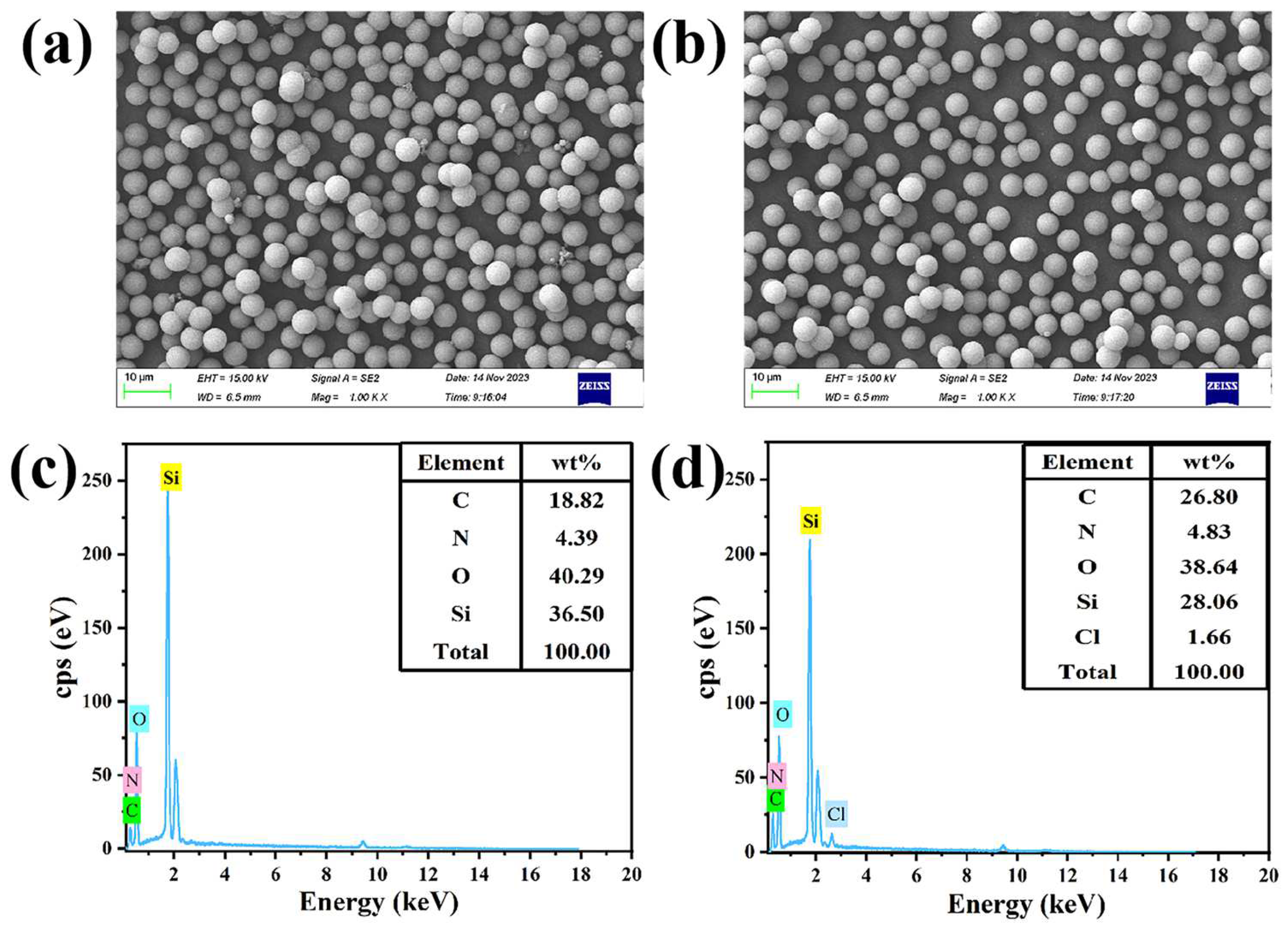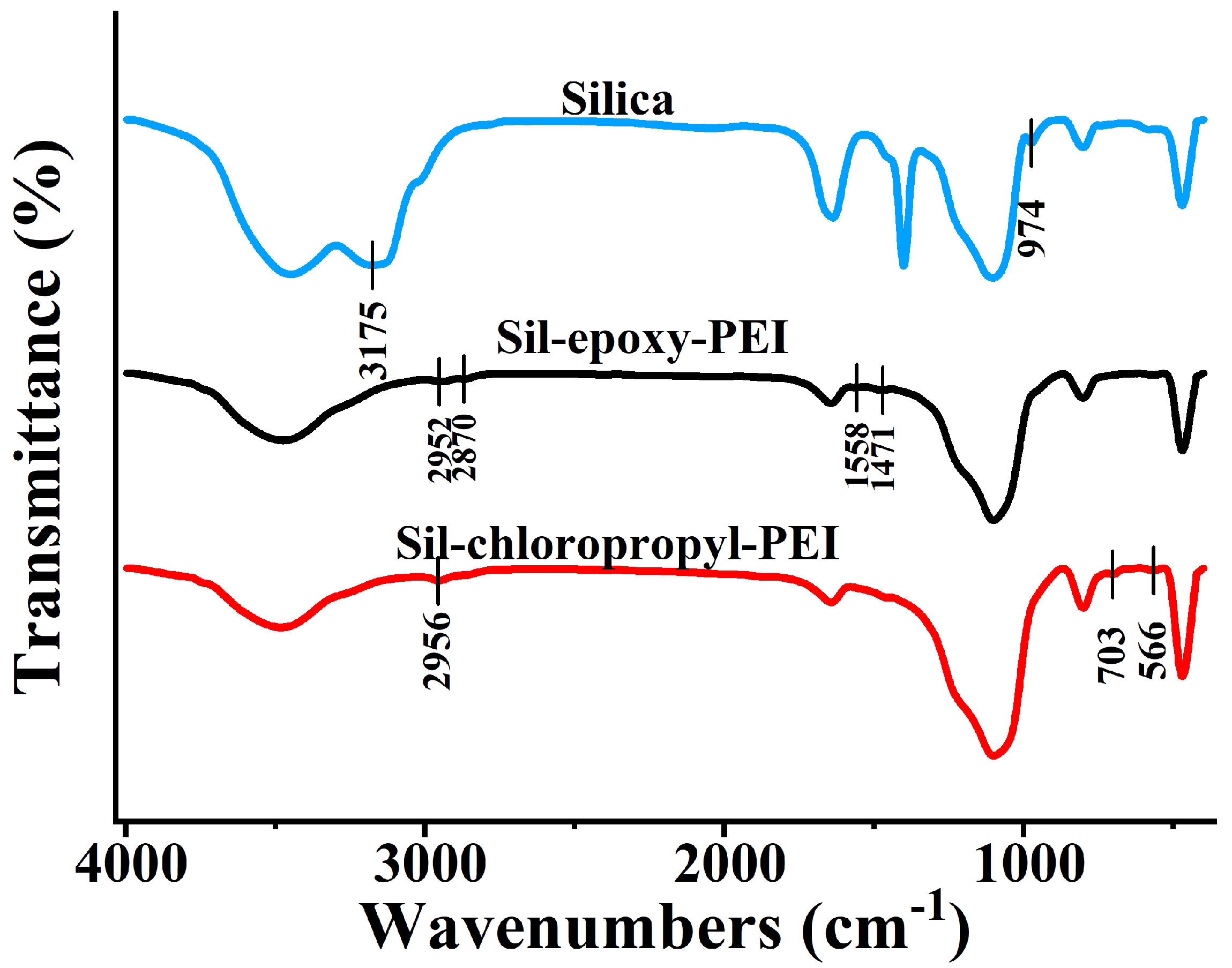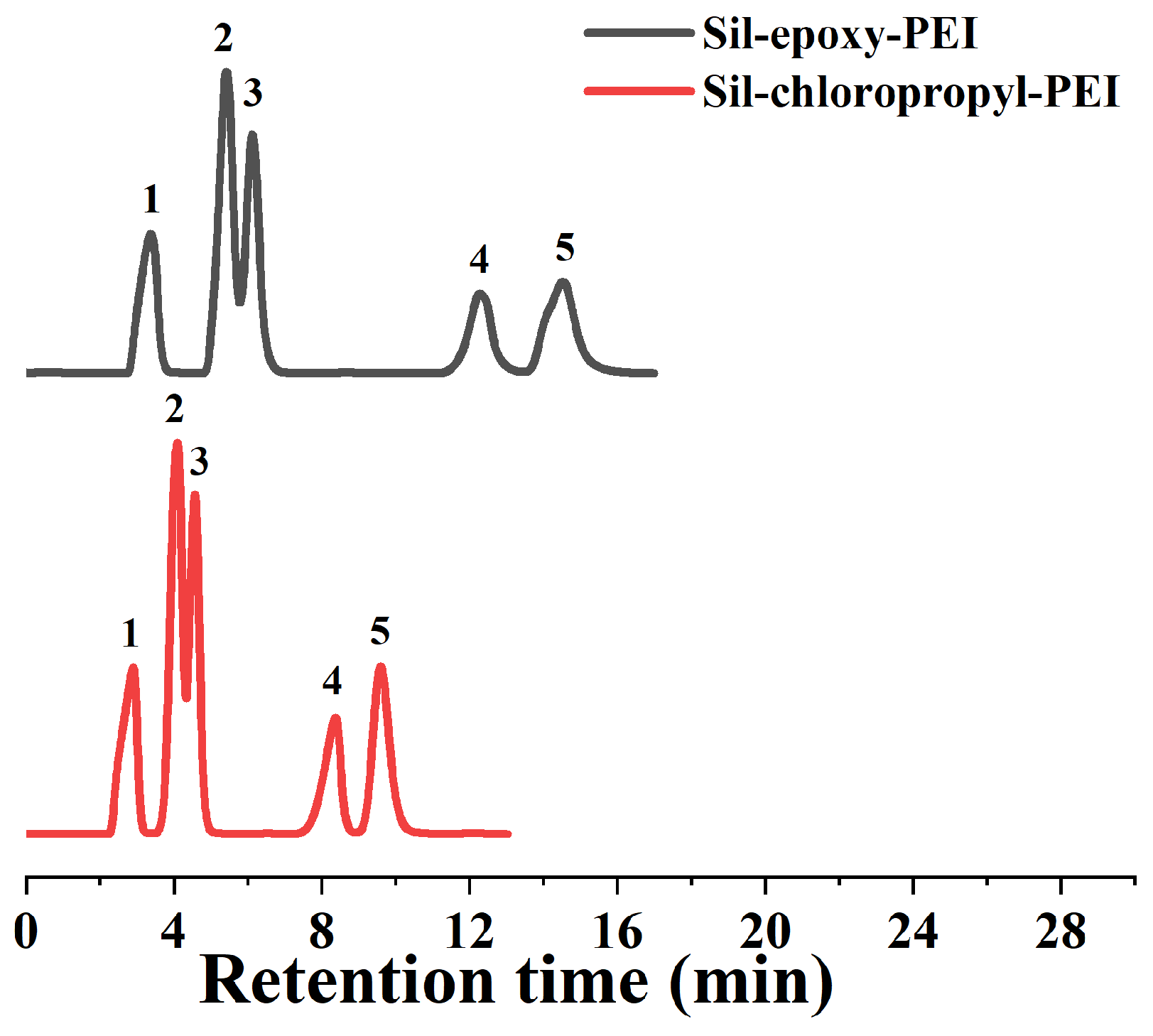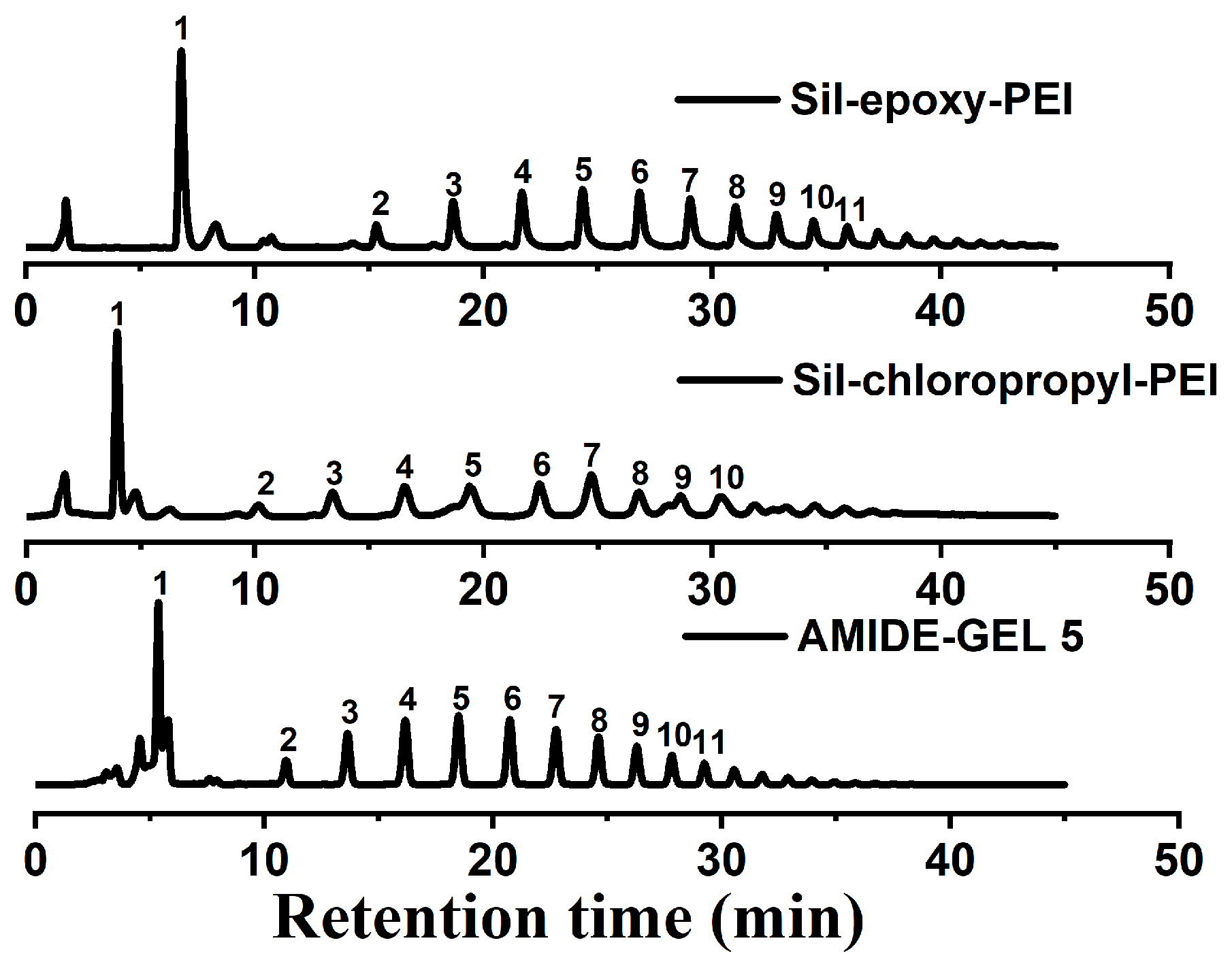Simplified Synthesis of Poly(ethyleneimine)-Modified Silica Particles and Their Application in Oligosaccharide Isolation Methods
Abstract
1. Introduction
2. Results and Discussion
2.1. Physical and Chemical Analysis Test of the Sil-Epoxy-PEI and Sil-Chloropropyl-PEI Materials
2.2. Chromatographic Evaluation of the Two Prepared Columns
2.2.1. Stability Evaluation of Batch-to-Batch Reproducibility
2.2.2. Chromatographic Separation Test of Nucleosides and Nucleoside Bases under HILIC Mode
2.3. Chromatographic Separation Comparison of Standard Saccharides Compounds under HILIC Mode
2.4. Chromatographic Separation of NPssaccharides Complex Samples under HILIC Mode
3. Conclusions
4. Experimental Section and Reagents and Materials
4.1. Instrumentation
4.2. Synthesis of Sil-Epoxy-PEI and Sil-Chloropropyl-PEI
4.2.1. Activation and Functional Modification
4.2.2. Synthesis of Sil-Epoxy-PEI, Sil-Chloropropyl-PEI and Other HILIC Particles
4.2.3. Column Packing Method
Supplementary Materials
Author Contributions
Funding
Institutional Review Board Statement
Informed Consent Statement
Data Availability Statement
Conflicts of Interest
Abbreviations
| HPLC | High-performance liquid chromatography |
| NPs | Natural products |
| TCM | Traditional Chinese medicine |
| HILIC | Hydrophilic interaction liquid chromatography |
| ELSD | Evaporative Light Scattering Detection |
| HTC | Hydrothermal carbon |
| TGA | Thermogravimetric analyzer |
| FT-IR | Fourier transform infrared spectroscopy |
| GSH | Glutathione |
| EDS or EDX | Energy-dispersive spectroscopy |
References
- Berlinck, R.G.; Monteiro, A.F.; Bertonha, A.F.; Bernardi, D.I.; Gubiani, J.R.; Slivinski, J.; Michaliski, L.F.; Tonon, L.A.; Venancio, V.A.; Freire, V.F. Approaches for the isolation and identification of hydrophilic, light-sensitive, volatile and minor natural products. Nat. Prod. Rep. 2019, 36, 981–1004. [Google Scholar] [CrossRef] [PubMed]
- Strege, M.A. Hydrophilic interaction chromatography− electrospray mass spectrometry analysis of polar compounds for natural product drug discovery. Anal. Chem. 1998, 70, 2439–2445. [Google Scholar] [CrossRef]
- Zhang, Q.-W.; Lin, L.-G.; Ye, W.-C. Techniques for extraction and isolation of natural products: A comprehensive review. Chin. Med. 2018, 13, 20. [Google Scholar] [CrossRef] [PubMed]
- Li, S.-P.; Wu, D.-T.; Lv, G.-P.; Zhao, J. Carbohydrates analysis in herbal glycomics. TrAc Trends Anal. Chem. 2013, 52, 155–169. [Google Scholar] [CrossRef]
- Farsang, R.; Jarvas, G.; Guttman, A. Purification free N-glycan analysis by capillary zone electrophoresis: Hunt for the lost glycans. J. Pharm. Biomed. Anal. 2024, 238, 115812. [Google Scholar] [CrossRef]
- Andrasi, M.; Gyemant, G.; Sajtos, Z.; Nagy, C. Analysis of sugars in honey samples by capillary zone electrophoresis using fluorescence detection. Separations 2023, 10, 150. [Google Scholar] [CrossRef]
- Tian, Z.; Jiang, F.; Cong, H.; Zhu, S. Molecular weight determination of low molecular weight hyaluronic acid and chondroitin sulfate by gel permeation chromatography. Carbohydr. Polym. 2023, 311, 120488. [Google Scholar] [CrossRef]
- Deng, Y.; Han, B.-X.; Hu, D.-J.; Zhao, J.; Li, S.-P. Qualitation and quantification of water soluble non-starch polysaccharides from Pseudostellaria heterophylla in China using saccharide mapping and multiple chromatographic methods. Carbohydr. Polym. 2018, 199, 619–627. [Google Scholar] [CrossRef]
- Kartsova, L.; Maliushevska, A.; Kolobova, E. Analytical Capabilities of the Determination of Carbohydrates by Chromatographic and Electrophoretic Methods. J. Anal. Chem. 2023, 78, 144–161. [Google Scholar] [CrossRef]
- Lijina, P.; Kumar, B.G. Discrimination of raffinose and planteose based on porous graphitic carbon chromatography in combination with mass spectrometry. J. Chromatogr. B 2023, 1224, 123758. [Google Scholar] [CrossRef]
- Donahue, T.C.; Zong, G.; Ou, C.; DeShong, P.; Wang, L.-X. Catanionic vesicles as a facile scaffold to display natural n-glycan ligands for probing multivalent carbohydrate–lectin interactions. Bioconjug. Chem. 2023, 34, 392–404. [Google Scholar] [CrossRef]
- Sheng, Q.; Liu, M.; Lan, M.; Qing, G. Hydrophilic interaction liquid chromatography promotes the development of bio-separation and bio-analytical chemistry. TrAc Trends Anal. Chem. 2023, 165, 117148. [Google Scholar] [CrossRef]
- Yang, M.; Mei, H.; Jiang, Y.; Zhang, F.; Yu, Z.; Yang, B. Simultaneous chromatographic separation of the anomers of saccharides on a polymer sulfobetaine zwitterionic stationary phase. J. Sep. Sci. 2024, 47, e2300905. [Google Scholar] [CrossRef] [PubMed]
- Liu, X.; Jiang, Y.; Zhang, F.; Li, Z.; Yang, B. Preparation and evaluation of a polymer-based sulfobetaine zwitterionic stationary phase. J. Chromatogr. A 2021, 1649, 462229. [Google Scholar] [CrossRef] [PubMed]
- Fu, Q.; Liang, T.; Zhang, X.; Du, Y.; Guo, Z.; Liang, X. Carbohydrate separation by hydrophilic interaction liquid chromatography on a ‘click’ maltose column. Carbohydr. Res. 2010, 345, 2690–2697. [Google Scholar] [CrossRef]
- Xiong, Y.; Li, X.; Li, M.; Qin, H.; Chen, C.; Wang, D.; Wang, X.; Zheng, X.; Liu, Y.; Liang, X.; et al. What is hidden behind Schiff base hydrolysis? Dynamic covalent chemistry for the precise capture of sialylated glycans. J. Am. Chem. Soc. 2020, 142, 7627–7637. [Google Scholar] [CrossRef]
- Liu, H.; Jin, P.; Jiang, M.; Duan, Y.; Zhu, G.; Yu, H.; Qiu, H. Performance evaluation of silica microspheres functionalized by different amine-ligands for hydrophilic interaction chromatography. J. Chromatogr. A 2021, 1640, 461967. [Google Scholar] [CrossRef]
- Yu, Z.; Li, Z.; Zhang, F.; Yang, B. A lysine and amide functionalized polymer-based polar stationary phase for hydrophilic interaction chromatography. J. Chromatogr. A 2023, 1708, 464328. [Google Scholar] [CrossRef]
- Ma, M.; Lu, X.; Guo, Y.; Wang, L.; Liang, X. Combination of metal-organic frameworks (MOFs) and covalent organic frameworks (COFs): Recent advances in synthesis and analytical applications of MOF/COF composites. TrAc Trends Anal. Chem. 2022, 157, 116741. [Google Scholar] [CrossRef]
- Gao, L.; Wang, Y.; Qin, Y.; Sun, Y.; He, L.; Zhang, S.; Zhao, W. Preparation and characterization of glucose-based covalent organic polymer coated silica as stationary phase for high-performance liquid chromatography. J. Chromatogr. A 2023, 1693, 463876. [Google Scholar] [CrossRef]
- Moni, L.; Ciogli, A.; D’Acquarica, I.; Dondoni, A.; Gasparrini, F.; Marra, A. Synthesis of sugar-based silica gels by copper-catalysed azide–alkyne cycloaddition via a single-step azido-activated silica intermediate and the use of the gels in hydrophilic interaction chromatography. Chem. Eur. J. 2010, 16, 5712–5722. [Google Scholar] [CrossRef] [PubMed]
- Shi, H.; Zhang, L. Maltose-functionalized HILIC stationary phase silica gel based on self-assembled oligopeptides and its application for the separation of polar compounds. Anal. Bioanal. Chem. 2022, 414, 3917–3925. [Google Scholar] [CrossRef] [PubMed]
- Zhao, X.; Liu, S.; Peng, J.; Li, X.; Niu, H.; Zhang, H.; Wang, L.; Wu, R. Facile one-pot synthesized hydrothermal carbon from cyclodextrin: A stationary phase for hydrophilic interaction liquid chromatography. J. Chromatogr. A 2019, 1585, 144–151. [Google Scholar] [CrossRef]
- Zhang, C.; Jin, X.; Wang, L.; Jin, C.; Han, X.; Ma, W.; Li, X.; Teng, G. Hollow MnFe2O4@C@APBA nanospheres with size exclusion and pH response for efficient enrichment of endogenous glycopeptides. ACS Appl. Mater. Interfaces 2021, 13, 9714–9728. [Google Scholar] [CrossRef] [PubMed]
- Niu, H.; Li, X.; Peng, J.; Zhang, H.; Zhao, X.; Zhou, X.; Yu, D.; Liu, X. The efficient profiling of serum N-linked glycans by a highly porous 3D graphene composite. Analyst 2019, 144, 5261–5270. [Google Scholar] [CrossRef]
- Wang, Y.; Bu, H.; Wang, L.; Wang, L.; Guo, Y.; Liang, X.; Wang, S. High efficiency and simple preparation of polyacrylamide coated silica stationary phase for hydrophilic interaction liquid chromatography. J. Chromatogr. A 2019, 1605, 360357. [Google Scholar] [CrossRef]
- Si, T.; Song, X.; Wang, L.; Guo, Y.; Liang, X.; Wang, S. Preparation and evaluation of hydrophobically associating polyacrylamide coated silica composite as high performance liquid chromatographic stationary phase. Microchem. J. 2020, 152, 104330. [Google Scholar] [CrossRef]
- Wang, X.; Cui, J.; Zhou, J.; Wang, S.; Gu, Y.; Liu, X.; Wang, S. Preparation of polyacrylamide hydrophilic stationary phases with adjustable performance. J. Chromatogr. A 2023, 1702, 464065. [Google Scholar] [CrossRef]
- Zhao, X.; Zhang, H.; Zhou, X.; Wang, L.; Wan, L. One-pot hydrothermal cross-linking preparation of poly (vinylpyrrolidone) immobilized silica stationary phase for hydrophilic interaction chromatography. J. Chromatogr. A 2020, 1633, 461656. [Google Scholar] [CrossRef]
- Peng, Y.; Zhang, F.; Pan, X.; Hou, Y.; Yang, B. Poly (vinyl alcohol)–cationic cellulose copolymer encapsulated SiO2 stationary phase for hydrophilic interaction liquid chromatography. RSC Adv. 2017, 7, 21336–21341. [Google Scholar] [CrossRef]
- Zhang, W.; Feng, Y.; Pan, L.; Zhang, G.; Guo, Y.; Zhao, W.; Xie, Z.; Zhang, S. Silica microparticles modified with ionic liquid bonded chitosan as hydrophilic moieties for preparation of high-performance liquid chromatographic stationary phases. Microchim. Acta 2023, 190, 176. [Google Scholar] [CrossRef] [PubMed]
- Rosenholm, J.M.; Penninkangas, A.; Lindén, M. Amino-functionalization of large-pore mesoscopically ordered silica by a one-step hyperbranching polymerization of a surface-grown polyethyleneimine. Chem. Commun. 2006, 37, 3909–3911. [Google Scholar] [CrossRef] [PubMed]
- Liu, L.; Yang, Z.; Liu, C.; Wang, M.; Chen, X. Preparation of PEI-modified nanoparticles by dopamine self-polymerization for efficient DNA delivery. Biotechnol. Appl. Biochem. 2023, 70, 824–834. [Google Scholar] [CrossRef] [PubMed]
- Martín, A.; García, R.; Karaman, D.S.; Rosenholm, J. Polyethyleneimine-functionalized large pore ordered silica materials for poorly water-soluble drug delivery. J. Mater. Sci. 2014, 49, 1437–1447. [Google Scholar] [CrossRef]
- Hierrezuelo, J.; Sadeghpour, A.; Szilagyi, I.; Vaccaro, A.; Borkovec, M. Electrostatic stabilization of charged colloidal particles with adsorbed polyelectrolytes of opposite charge. Langmuir 2010, 26, 15109–15111. [Google Scholar] [CrossRef]
- Çelebi, B.; Gökaltun, A.; Arman, E.; Evirgen, O.A.; Tuncel, A. Polyethylenimine attached-poly (3-chloro-2-hydroxypropyl methacrylate-co-ethylene dimethacrylate) monosized-porous microspheres as a new separation medium for polar compounds. Colloids Surf. A 2014, 441, 629–637. [Google Scholar] [CrossRef]
- Jiang, L.; Jin, Y.; Marcus, R.K. Polyethylenimine modified poly (ethylene terephthalate) capillary channeled-polymer fibers for anion exchange chromatography of proteins. J. Chromatogr. A 2015, 1410, 200–209. [Google Scholar] [CrossRef]
- Shen, Y.; Geng, H.; Zhang, F.; Li, Z.; Yang, B. A polyethyleneimine-functionalized polymer substrate polar stationary phase. J. Chromatogr. A 2023, 1689, 463711. [Google Scholar] [CrossRef]
- Jiang, L.; Marcus, R.K. Comparison of analytical protein separation characteristics for three amine-based capillary-channeled polymer (C-CP) stationary phases. Anal. Bioanal. Chem. 2016, 408, 1373–1383. [Google Scholar] [CrossRef]
- Wan, M.; Luo, Q.; Ren, X.; Zheng, Y.; Gao, D.; Fu, Q.; Zu, F.; Xia, Z.; Wang, L. Preparation and performance of a poly (ethyleneimine) embedded N-acetyl-L-phenylalanine mixed-mode stationary phase for HPLC. Microchem. J. 2020, 157, 105021. [Google Scholar] [CrossRef]
- Zu, F.; Qian, Z.; Li, F.; Ren, X.; Luo, Q.; Gao, D.; Zhou, D.; Zhang, K.; Xia, Z.; Wang, L. Poly (ethyleneimine) embedded octadecyl based stationary phase for multimodal chromatographic separation. Microchem. J. 2020, 156, 104917. [Google Scholar] [CrossRef]
- Yang, Y.; Zhang, H.; Chen, J.; Li, Z.; Zhao, L.; Qiu, H. A phenylenediamine-based carbon dot-modified silica stationary phase for hydrophilic interaction chromatography. Analyst 2020, 145, 1056–1061. [Google Scholar] [CrossRef] [PubMed]
- Yang, Y.; Zhou, J.; Liang, Q.; Dai, X.; Yang, H.; Wan, M.; Ou, J.; Liao, M.; Wang, L. Comparing the separation performance of poly (ethyleneimine) embedded butyric and octanoic acid based chromatographic stationary phases. J. Chromatogr. A 2023, 1706, 464268. [Google Scholar] [CrossRef] [PubMed]
- Shen, A.; Li, X.; Dong, X.; Wei, J.; Guo, Z.; Liang, X. Glutathione-based zwitterionic stationary phase for hydrophilic interaction/cation-exchange mixed-mode chromatography. J. Chromatogr. A 2013, 1314, 63–69. [Google Scholar] [CrossRef] [PubMed]







Disclaimer/Publisher’s Note: The statements, opinions and data contained in all publications are solely those of the individual author(s) and contributor(s) and not of MDPI and/or the editor(s). MDPI and/or the editor(s) disclaim responsibility for any injury to people or property resulting from any ideas, methods, instructions or products referred to in the content. |
© 2024 by the authors. Licensee MDPI, Basel, Switzerland. This article is an open access article distributed under the terms and conditions of the Creative Commons Attribution (CC BY) license (https://creativecommons.org/licenses/by/4.0/).
Share and Cite
Zhao, X.; Niu, Y.; Zhao, C.; Li, Z.; Li, K.; Qin, X. Simplified Synthesis of Poly(ethyleneimine)-Modified Silica Particles and Their Application in Oligosaccharide Isolation Methods. Int. J. Mol. Sci. 2024, 25, 9465. https://doi.org/10.3390/ijms25179465
Zhao X, Niu Y, Zhao C, Li Z, Li K, Qin X. Simplified Synthesis of Poly(ethyleneimine)-Modified Silica Particles and Their Application in Oligosaccharide Isolation Methods. International Journal of Molecular Sciences. 2024; 25(17):9465. https://doi.org/10.3390/ijms25179465
Chicago/Turabian StyleZhao, Xingyun, Yifan Niu, Chengxiao Zhao, Zhenyu Li, Ke Li, and Xuemei Qin. 2024. "Simplified Synthesis of Poly(ethyleneimine)-Modified Silica Particles and Their Application in Oligosaccharide Isolation Methods" International Journal of Molecular Sciences 25, no. 17: 9465. https://doi.org/10.3390/ijms25179465
APA StyleZhao, X., Niu, Y., Zhao, C., Li, Z., Li, K., & Qin, X. (2024). Simplified Synthesis of Poly(ethyleneimine)-Modified Silica Particles and Their Application in Oligosaccharide Isolation Methods. International Journal of Molecular Sciences, 25(17), 9465. https://doi.org/10.3390/ijms25179465






